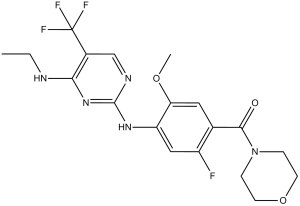GNE-7915 (GNE 7915; GNE7915) is a novel, highly potent, selective, and brain-penetrant leucine-rich repeat kinase 2 (LRRK2) inhibitor with anti-PD (Parkinson's disease) activity. It inhibits LRRK2 with an IC50 and a Ki of 9 nM and 1 nM, respectively. GEN-7915 has been shown to induce dephosphorylation of LRRK2 in the brain of transgenic mice. GNE-7915 is not reported to cause cellular or genetic toxicity, and has progressed into preclinical studies in cynomolgus monkeys. Inhibition of LRRK2 kinase activity has neuroprotective benefits, and provides a means of addressing the underlying biochemical cause of Parkinson's disease for the first time.
Physicochemical Properties
| Molecular Formula | C19H21F4N5O3 |
| Molecular Weight | 443.40 |
| Exact Mass | 443.158 |
| CAS # | 1351761-44-8 |
| Related CAS # | GNE-7915 tosylate;2070015-00-6 |
| PubChem CID | 58539171 |
| Appearance | Off-white to light yellow solid powder |
| Density | 1.4±0.1 g/cm3 |
| Boiling Point | 629.9±65.0 °C at 760 mmHg |
| Flash Point | 334.7±34.3 °C |
| Vapour Pressure | 0.0±1.8 mmHg at 25°C |
| Index of Refraction | 1.578 |
| LogP | 1.81 |
| Hydrogen Bond Donor Count | 2 |
| Hydrogen Bond Acceptor Count | 11 |
| Rotatable Bond Count | 6 |
| Heavy Atom Count | 31 |
| Complexity | 593 |
| Defined Atom Stereocenter Count | 0 |
| InChi Key | XCFLWTZSJYBCPF-UHFFFAOYSA-N |
| InChi Code | InChI=1S/C19H21F4N5O3/c1-3-24-16-12(19(21,22)23)10-25-18(27-16)26-14-9-13(20)11(8-15(14)30-2)17(29)28-4-6-31-7-5-28/h8-10H,3-7H2,1-2H3,(H2,24,25,26,27) |
| Chemical Name | (4-((4-(ethylamino)-5-(trifluoromethyl)pyrimidin-2-yl)amino)-2-fluoro-5-methoxyphenyl)(morpholino)methanone |
| Synonyms | GNE 7915; GNE-7915; GNE7915; |
| HS Tariff Code | 2934.99.9001 |
| Storage |
Powder-20°C 3 years 4°C 2 years In solvent -80°C 6 months -20°C 1 month |
| Shipping Condition | Room temperature (This product is stable at ambient temperature for a few days during ordinary shipping and time spent in Customs) |
Biological Activity
| ln Vitro | For GNE-7915 and compound 19, single-digit nanomolar LRRK2 cell activity was obtained by keeping the methoxy/fluoro arrangement at C-2'/C-5' and varying the aminoalkyl R1 substitutions. Only TTK demonstrated more than 50% inhibition when the Invitrogen kinase assay was expanded to include 0.1 μM (187 kinases) of GNE-7915 (100-fold LRRK2 Ki) and 19 (250-fold LRRK2 Ki). At 0.1 μM, a selectivity analysis of GNE-7915 was conducted utilizing the DiscoverX KinomeScan55 competitive binding assay panel, which comprises 392 distinct kinases. Probe-shift binding was observed at >50% for 10 kinases and >65% exclusively for LRRK2, TTK, and ALK, thereby corroborating GNE-7915's exceptional selectivity for LRRK2. GNE-7915 and 19 only inhibited 5-HT2B, with >70% inhibition at 10 μM, according to cerep receptor analysis (including extended brain panel). In vitro functional tests have demonstrated that GNE-7915 and 19 are moderately potent 5-HT2B antagonists [2]. | ||
| ln Vivo |
|
||
| Animal Protocol |
|
||
| References |
[1]. The development of CNS-active LRRK2 inhibitors using property-directed optimisation. Bioorg Med Chem Lett.?2013 Jul 1;23(13):3690-6. [2]. Discovery of highly potent, selective, and brain-penetrable leucine-rich repeat kinase 2 (LRRK2) small molecule inhibitors. J Med Chem. 2012 Nov 26;55(22):9416-33. |
Solubility Data
| Solubility (In Vitro) |
|
|||
| Solubility (In Vivo) |
Solubility in Formulation 1: ≥ 2.5 mg/mL (5.64 mM) (saturation unknown) in 10% DMSO + 40% PEG300 + 5% Tween80 + 45% Saline (add these co-solvents sequentially from left to right, and one by one), clear solution. For example, if 1 mL of working solution is to be prepared, you can add 100 μL of 25.0 mg/mL clear DMSO stock solution to 400 μL PEG300 and mix evenly; then add 50 μL Tween-80 to the above solution and mix evenly; then add 450 μL normal saline to adjust the volume to 1 mL. Preparation of saline: Dissolve 0.9 g of sodium chloride in 100 mL ddH₂ O to obtain a clear solution. Solubility in Formulation 2: 2.5 mg/mL (5.64 mM) in 10% DMSO + 90% (20% SBE-β-CD in Saline) (add these co-solvents sequentially from left to right, and one by one), suspension solution; with ultrasonication. For example, if 1 mL of working solution is to be prepared, you can add 100 μL of 25.0 mg/mL clear DMSO stock solution to 900 μL of 20% SBE-β-CD physiological saline solution and mix evenly. Preparation of 20% SBE-β-CD in Saline (4°C,1 week): Dissolve 2 g SBE-β-CD in 10 mL saline to obtain a clear solution. Solubility in Formulation 3: ≥ 2.5 mg/mL (5.64 mM) (saturation unknown) in 10% DMSO + 90% Corn Oil (add these co-solvents sequentially from left to right, and one by one), clear solution. For example, if 1 mL of working solution is to be prepared, you can add 100 μL of 25.0 mg/mL clear DMSO stock solution to 900 μL of corn oil and mix evenly. Solubility in Formulation 4: ≥ 2.5 mg/mL (5.64 mM) (saturation unknown) in 5% DMSO + 40% PEG300 + 5% Tween80 + 50% Saline (add these co-solvents sequentially from left to right, and one by one), clear solution. Preparation of saline: Dissolve 0.9 g of sodium chloride in 100 mL ddH₂ O to obtain a clear solution. (Please use freshly prepared in vivo formulations for optimal results.) |
| Preparing Stock Solutions | 1 mg | 5 mg | 10 mg | |
| 1 mM | 2.2553 mL | 11.2765 mL | 22.5530 mL | |
| 5 mM | 0.4511 mL | 2.2553 mL | 4.5106 mL | |
| 10 mM | 0.2255 mL | 1.1276 mL | 2.2553 mL |
